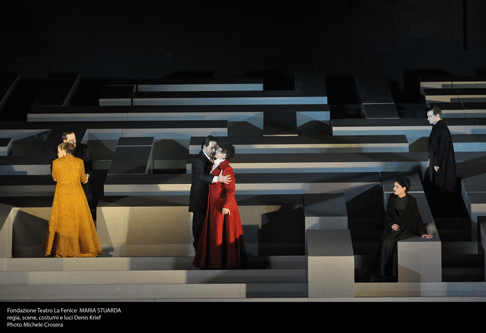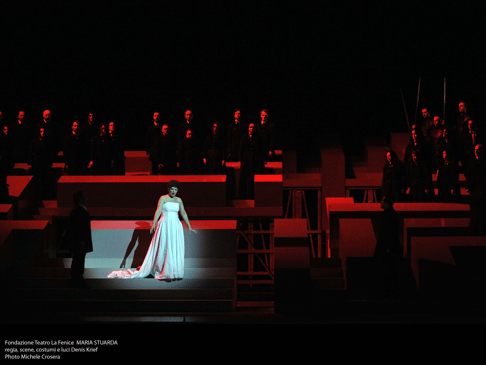29 Apr 2009
Donizetti’s “Maria Stuarda” at La Fenice — Two Women in a Labyrinth
From the word “go”, the audience feels that this “Maria Stuarda” is quite different from the standard fare offered by Italian theatres.

From the word “go”, the audience feels that this “Maria Stuarda” is quite different from the standard fare offered by Italian theatres.
There are no cardboard Elizabethan “magnificent” halls and throne rooms; neither Piranesi’s grand jails in a bleak London Tower in the “finale”; neither a thick forest for the Royal hunt in the last scene of the first part. On the stage there is only a maze — indeed a labyrinth in granite where a fight is being fought by two tormented women in love for the same man — and also starving for the crown of Britain. The costumes have nothing to do with the XVI century; they are quite elegant but in a style closer to the high fashion of the 1950s (or slightly earlier) than to those of the historical period when the contest of the two Queens for the British crown actually took place. The plot develops today — somewhere in some country — but could have taken place even a few years ago or tomorrow. It is a perennial struggle in a-temporal setting and costumes.
A few conservative critics raised their eyebrows, but on April 24th — the opening night of this new production- La Fenice audience, not necessarily the cream of most advanced experimentalism in stage direction, loved it: the performance received a standing ovation. The just unveiled new production by Denis Krief , an Italian-based French-Tunisian director, is especially important because it is a joint effort with other major Opera Houses — Teatro Verdi in Trieste, San Carlo in Naples, Massimo in Palermo — where it will be shown starting next Fall. Krief is French-Tunisian but raised , as a stage Director, in Italy. However, the set, costumes and direction reflect the best experience of modern German opera production: Krief himself is a frequent guest director in the Federal Republic where he recently produced a successful “Ring”.
“Maria Stuarda” is the most frequently performed opera of the Donizetti’s trilogy about the Tudor Queens. The other two are “Anna Bolena” and “Roberto Devereux”. To be meticulous, the reviewer should include also “Elisabetta al Castello di Keniworth”, seldom seen on a stage and a “semi-seria opera” with a happy ending, quite distant from the tragedy atmosphere of the other three. In Anders Wiklund’s critical edition of the score, “Maria Stuarda” is compact (about two hours of music as compared to nearly three of “Anna Bolena” and “Roberto Devereux) and emphasizes the confrontation between the two Queens over the man each of them is longing for rather than the historical power struggle. As a matter of fact, Schiller’s play (the basis for the libretto) takes little notice of historical facts: Mary was 45 when she died (after 8 years in prison) and Elisabeth 53 (and had never been a beauty). Neither the Earl of Leicester appears to have been such a good looking fellow to cause such a bloody fight by two Queens. Wiklund’s edition emphasizes the sentimental and erotic tension rather than the politics surrounding it — key ingredient of the manipulated versions seen both until the mid-XIX century (when “Maria Stuarda” disappeared from the stages of the world) and from 1958 (revival in Bergamo) to the 1990s (a period when it was a war horse of Beverly Sills, Leyla Gencer, Edita Gruberova, Monsterrat Caballé and Joan Sutherland). This is, in my view, a justification for the labyrinth: it was a key element both in many a Shakespeare’s plays (as well as of gardening in that period) and quite a few Schiller’s plays.

As in many Donizetti’s opera, orchestration is rather simple; it is meant to support vocal acrobatics by the main singers. Fabrizio Maria Carminati is well aware of it and his conducting is diligent and effective. The attention is to the two protagonist. Elisabeth must be a “mezzo spinto” with an excellent flare for ascending to acute; Sonia Ganassi is veteran of the role (there are some excellent recording) and on April 24 gave an extraordinary performance — both vocally and dramatically- especially if account is taken that, at the age of 43, Ms. Ganassi is five month pregnant of her first child. Maria is a “soprano assoluto” with coloratura arias sliding into declamation and vice versa. For Fiorenza Cedolins April 24 was the night of the debut of in the role. There was some trepidation that she would not have been able to cope with the highly difficult score; as a matter of fact, in her career she had started with coloratura but had then gone to “verismo” (Tosca, Butterfly), not the most effective way to prepare oneself sing a “soprano assoluto” with coloratura , as required by “Maria Stuarda”: some imperfection in the first part but standing ovation in the jail-confession scene of the second part and in the finale. José Bros has sang Leicester may times. Normally this good tenor with a high texture is good vocally but on the stage is a sexy as an umbrella. Miraculously, Krief makes him very sensual. With both Queens.
Giuseppe Pennisi
